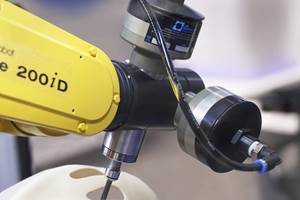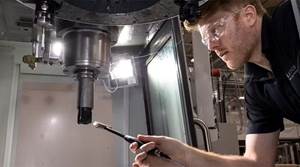High Speed Machining ... Without The Speed
Axial chip thinning is often associated with high speed machining, but this shop uses the same effect to increase metal removal rate with a standard-size end mill run on a moderate-speed machine.
Share






As the very name of the shop makes clear, Robertson EDM doesn’t specialize in machining center work. This job shop in Edgerton, Ohio, has four wire EDM machines and one sinker EDM machine, but at present only one CNC machining center—a reliable Mazak VTC-16B vertical that the shop purchased used.
However, as the shop continues to succeed and continues to draw more business just by word of mouth, both the range of work and the range of opportunities continue to grow more broad. To take on large-diameter turning work, for example, the shop recently invested in a Johnford ST-40A slant-bed turning center with 31 inches of swing over the bed from Absolute Machine Tools. The volume of work for its machining center is also increasing, and the shop has met this challenge by implementing high speed machining on this VMC—sort of.
The term “high speed machining,” particularly in applications involving steel, often refers to small tools run at high spindle speeds and feed rates with light depths of cut. Despite the light cuts, machining in this way achieves a high metal removal rate by taking the passes very rapidly. The passes can then become even more rapid when using a ballnose end mill, because a ballnose tool making a light cut takes advantage of axial chip thinning. By virtue of this effect, the chip thickness is smaller than the advance per tooth. This means that the advance per tooth can be increased, and correspondingly the linear feed rate in inches per minute can be increased even beyond what the high spindle speed already allows.
But that’s high speed machining. By contrast, Robertson EDM does not have particularly high spindle speed, nor does it have the complex 3D milling work that could benefit from a small-diameter ballnose tool. However, the chip thinning that increases feed rate in high speed machining is still a real and valuable option for this shop, even with a tool that has a larger diameter. To increase its own metal removal rate, the shop employs a tool design supplied by Iscar that realizes the chip thinning effect. The insert design, called “Feedmill,” features a curved profile that makes this possible. Chip thinning, in other words, does not need a ballnose tool and does not need a small tool diameter. At least this one aspect of high speed machining can be applied in a more standard roughing application on a moderate-speed machine.
Chip Thinning In Action
One of the shop’s general partners is Jeffrey Robertson. The local sales and applications representative for Iscar is Greg Mallett. Mr. Mallett was meeting with Mr. Robertson to tool up the new turning center when he saw an application for the axial-chip-thinning insert. Robertson EDM was roughing a fixture component out of cold-rolled steel, and the way the shop was machining this part actually provided an excellent basis for a before-and-after comparison. The part was too big for the machining center’s travels, so the shop was machining it in halves.
After the first half was finished with a 0.75-inch inserted tool, the shop agreed to run the second half with a 0.75-inch tool body using the chip-thinning insert design. The tool with the latter insert cut with one tooth instead of two, and it also took a lighter depth of cut. However, because of the higher feed rate resulting from chip thinning, productivity increased. Tool life increased, too.
The curved profile of the insert begins as a 0.106-inch radius, blending into a 0.5-inch radius. A depth of cut light enough to fall along this curve features an advance per tooth that can “cheat” its way higher, because the chip thickness is lighter than the advance per tooth instead of being equal to it.
The greater tool life the shop saw can be attributed to the curved profile, too, says Mr. Mallett. The tool life increase that Robertson EDM observed was likely the result of a more stable cut, he says. As is the case with a ballnose tool, the material meeting the curve of the tool at a point below the tool’s full radius exerts a cutting force that is not entirely lateral, but instead pushes up toward the centerpoint of the ball. In other words, only some of the cutting force is directed along X and Y. The remainder is directed along Z, the direction of the spindle, which is the most rigid of the three axes. With correspondingly less force directed along the side of the tool, there is that much less opportunity for tool deflection, and the cut is that much more stable.
As a result, capacity has increased on the shop’s machining center. The shop now routinely uses this tool for its steel-roughing applications—the transmission cover on p. 98 is another example of a part for which the tool was suited. As the shop continues to grow, no doubt its number of machining centers will grow as well—perhaps one day to include a high speed machine. For now, however, the additional capacity provided by faster roughing feed rates is enough to meet the need.
Related Content
How to Accelerate Robotic Deburring & Automated Material Removal
Pairing automation with air-driven motors that push cutting tool speeds up to 65,000 RPM with no duty cycle can dramatically improve throughput and improve finishing.
Read MoreShoulder Milling Cuts Racing Part's Cycle Time By Over 50%
Pairing a shoulder mill with a five-axis machine has cut costs and cycle times for one of TTI Machine’s parts, enabling it to support a niche racing community.
Read MoreHow to Mitigate Chatter to Boost Machining Rates
There are usually better solutions to chatter than just reducing the feed rate. Through vibration analysis, the chatter problem can be solved, enabling much higher metal removal rates, better quality and longer tool life.
Read MoreMeasuring Torque, Thrust Force for Smart Drilling Operations
To monitor drilling operations for smart manufacturing solutions, torque and thrust force can be measured.
Read MoreRead Next
Machine Shop MBA
Making Chips and 91ÊÓƵÍøÕ¾ÎÛ are teaming up for a new podcast series called Machine Shop MBA—designed to help manufacturers measure their success against the industry’s best. Through the lens of the Top Shops benchmarking program, the series explores the KPIs that set high-performing shops apart, from machine utilization and first-pass yield to employee engagement and revenue per employee.
Read MoreLast Chance! 2025 Top Shops Benchmarking Survey Still Open Through April 30
Don’t miss out! 91ÊÓƵÍøÕ¾ÎÛ's Top Shops Benchmarking Survey is still open — but not for long. This is your last chance to a receive free, customized benchmarking report that includes actionable feedback across several shopfloor and business metrics.
Read MoreAMRs Are Moving Into Manufacturing: Considerations for Implementation
AMRs can provide a flexible, easy-to-use automation platform so long as manufacturers choose a suitable task and prepare their facilities.
Read More






















